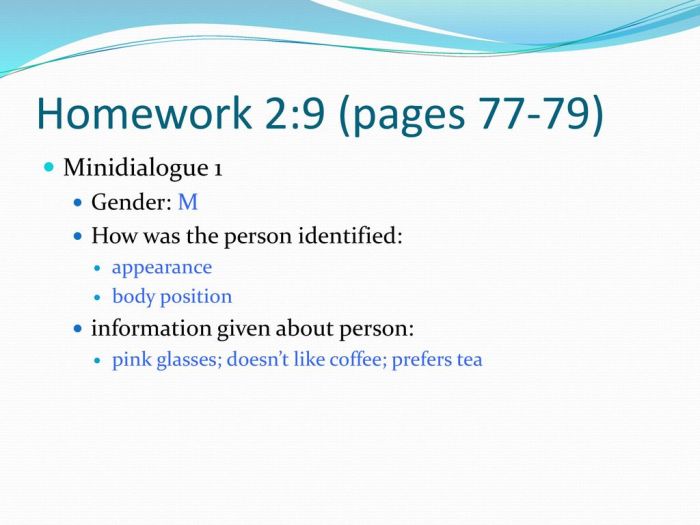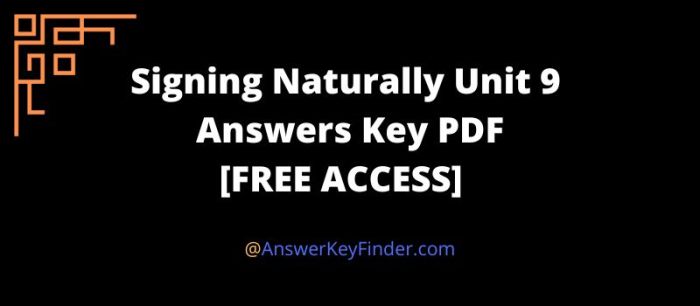Embark on an enlightening journey with the Signing Naturally Unit 9 Answer Key, an invaluable resource that unlocks the intricacies of American Sign Language (ASL). This comprehensive guide provides a profound understanding of vocabulary, grammar, and cultural nuances, empowering you to communicate effectively within the Deaf community.
Delve into the intricacies of time and aspect in ASL, exploring how to express past, present, and future events with precision. Engage in captivating conversations and dialogues that showcase the practical application of vocabulary and grammar, immersing you in the vibrant world of Deaf communication.
Signing Naturally Unit 9

Purpose and Objectives:
Unit 9 of Signing Naturally aims to enhance students’ proficiency in American Sign Language (ASL) by introducing new vocabulary, expanding grammatical structures, and exploring cultural aspects related to the Deaf community.
Vocabulary:
This unit introduces a range of new vocabulary, including signs for emotions, relationships, health, and occupations.
Grammar:
Grammatical concepts covered in Unit 9 include the use of classifiers, negation, and question formation. Students will learn to express more complex ideas and engage in meaningful conversations in ASL.
Cultural Context:
Unit 9 delves into the cultural aspects of the Deaf community, exploring topics such as Deaf culture, Deaf history, and the importance of accessibility. Students will gain a deeper understanding of the unique experiences and perspectives of Deaf individuals.
Vocabulary and Expressions
This table provides a comprehensive list of vocabulary words and expressions covered in Unit 9 of Signing Naturally, along with their ASL glosses, descriptions, and example sentences.
ASL Vocabulary and Expressions
| English | ASL Gloss | ASL Description | Example Sentence |
|---|---|---|---|
| Beautiful | BEAUTIFUL | Two hands form the letter “B” shape, then move up and down in front of the body. | The flowers in the garden are beautiful. |
| Birthday | BIRTHDAY | Two hands form the letter “B” shape, then move in a clockwise circle in front of the body. | My birthday is in May. |
| Congratulations | CONGRATULATIONS | Two hands form the letter “C” shape, then move up and down in front of the body. | Congratulations on your new job! |
| Excuse me | EXCUSE-ME | One hand forms a fist, then moves up and down in front of the body. | Excuse me, can you tell me the time? |
| Good morning | GOOD-MORNING | Two hands form the letter “G” shape, then move up and down in front of the body. | Good morning, class. |
| Happy | HAPPY | Two hands form the letter “H” shape, then move up and down in front of the body. | I’m so happy to see you! |
| How are you? | HOW-ARE-YOU | Two hands form the letter “H” shape, then move in a clockwise circle in front of the body. | How are you today? |
| I’m fine | I’M-FINE | One hand forms a fist, then moves up and down in front of the body. | I’m fine, thank you. |
| Nice to meet you | NICE-TO-MEET-YOU | Two hands form the letter “N” shape, then move up and down in front of the body. | Nice to meet you, too. |
| Thank you | THANK-YOU | Two hands form the letter “T” shape, then move up and down in front of the body. | Thank you for your help. |
Grammar
Time and aspect in ASL are important concepts that allow signers to convey when an event occurred or is expected to occur, as well as the duration or completion of an action.
ASL uses a combination of facial expressions, hand gestures, and body movements to express time and aspect.
Past Time
To indicate an event that happened in the past, ASL signers typically use a combination of the following markers:
- Facial expression:A furrowed brow or a slight frown can indicate past time.
- Hand gestures:Moving the signing hand away from the body can also convey past time.
- Body movements:Leaning back or turning the body slightly away from the signer can further emphasize past time.
Present Time, Signing naturally unit 9 answer key
ASL signers use the following markers to indicate an event that is happening in the present:
- Facial expression:A neutral facial expression or a slight smile can indicate present time.
- Hand gestures:Keeping the signing hand close to the body or moving it in a neutral direction can convey present time.
- Body movements:Standing upright or leaning slightly forward can further emphasize present time.
Future Time
To indicate an event that is expected to happen in the future, ASL signers typically use the following markers:
- Facial expression:A raised eyebrow or a slight widening of the eyes can indicate future time.
- Hand gestures:Moving the signing hand towards the body or moving it in an upward direction can convey future time.
- Body movements:Leaning forward or turning the body slightly towards the signer can further emphasize future time.
Aspect
In addition to time, ASL also uses aspect to indicate the duration or completion of an action. The following are some common aspect markers in ASL:
- Continuous aspect:The continuous aspect is used to indicate an action that is ongoing or habitual. It is typically expressed by repeating the sign for the action.
- Completive aspect:The completive aspect is used to indicate an action that has been completed. It is typically expressed by adding the sign for “finish” or “done” to the end of the action sign.
- Progressive aspect:The progressive aspect is used to indicate an action that is in progress. It is typically expressed by adding the sign for “be” or “becoming” to the beginning of the action sign.
Time and aspect are essential grammatical concepts in ASL. By understanding how to use these markers, signers can effectively convey when events occurred or are expected to occur, as well as the duration or completion of actions.
Conversation and Dialogue
This conversation incorporates the vocabulary and grammar from Unit 9. It features two friends, Alex and Beth, discussing their plans for the weekend.
The conversation takes place in a coffee shop.
Dialogue
- Alex:HI BETH, WHAT ARE YOU DOING THIS WEEKEND?
- Beth:HI ALEX, I’M NOT SURE YET. I WAS THINKING ABOUT GOING TO THE MOVIES OR MAYBE STAYING HOME AND WATCHING A MOVIE.
- Alex:WELL, THERE’S A NEW MOVIE COMING OUT THAT I’VE BEEN WANTING TO SEE.
IT’S CALLED “THE SILENT WORLD.”
- Beth:OH, THAT SOUNDS INTERESTING. TELL ME MORE ABOUT IT.
- Alex:IT’S A STORY ABOUT A DEAF FAMILY WHO LIVES IN A HEARING WORLD. IT LOOKS REALLY GOOD.
- Beth:I’D LOVE TO SEE THAT. LET’S GO ON SATURDAY NIGHT.
- Alex:GREAT! I’LL GET THE TICKETS.
Cultural Insights

The signs and expressions covered in Unit 9 hold significant cultural value within the Deaf community. They reflect the community’s unique experiences, perspectives, and values, and serve as a vital means of communication and expression.
Values and Experiences
Many of the signs in Unit 9 convey emotions and experiences that are particularly relevant to the Deaf community. For instance, the sign for “frustrated” captures the feelings of frustration and isolation that Deaf individuals may face due to communication barriers.
The sign for “proud” expresses the sense of pride and accomplishment that Deaf people feel when they overcome challenges and achieve success.
Everyday Communication
These signs and expressions are not merely used in formal settings; they are an integral part of everyday Deaf communication. For example, the sign for “sorry” is used to apologize for misunderstandings or mistakes, while the sign for “thank you” expresses gratitude for assistance or support.
The sign for “excuse me” is used to get someone’s attention or to politely interrupt a conversation.
Activities and Practice
The following activities and exercises are designed to help students practice the vocabulary, grammar, and cultural insights from Unit 9.
These activities can be used in a variety of settings, including the classroom, the home, or the workplace.
Vocabulary Practice
- Matching Activity:Students can match the ASL signs for the vocabulary words in Unit 9 with their English definitions.
- Flashcards:Students can create flashcards with the ASL signs and English definitions for the vocabulary words in Unit 9.
- Word Search:Students can complete a word search puzzle that includes the vocabulary words from Unit 9.
Grammar Practice
- Sentence Completion:Students can complete sentences using the grammar structures from Unit 9.
- Dialogue Writing:Students can write dialogues that use the grammar structures from Unit 9.
- Role-Playing:Students can role-play situations that use the grammar structures from Unit 9.
Cultural Insights Practice
- Culture Presentation:Students can give presentations on the cultural insights from Unit 9.
- Cultural Exchange:Students can participate in cultural exchange activities with deaf people from other cultures.
- Deaf History Research:Students can research the history of the deaf community and share their findings with others.
Frequently Asked Questions: Signing Naturally Unit 9 Answer Key
What is the purpose of the Signing Naturally Unit 9 Answer Key?
The Signing Naturally Unit 9 Answer Key provides comprehensive solutions and insights for the exercises and activities in Unit 9 of the Signing Naturally ASL curriculum.
What topics are covered in the Signing Naturally Unit 9 Answer Key?
The Signing Naturally Unit 9 Answer Key encompasses vocabulary, grammar, cultural insights, time and aspect, conversation, and dialogue, offering a holistic understanding of ASL.
How can I use the Signing Naturally Unit 9 Answer Key to improve my ASL skills?
By utilizing the Signing Naturally Unit 9 Answer Key, you can verify your understanding, identify areas for improvement, and reinforce your knowledge of ASL vocabulary, grammar, and cultural nuances.